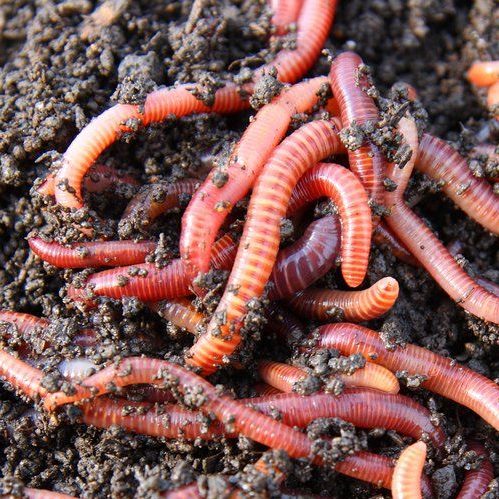Taking Advantage Of the Power of Red Wigglers for Lasting Gardening
The combination of red wigglers into sustainable gardening practices provides a compelling chance for enhancing soil health and wellness and minimizing organic waste. These worms excel at transforming kitchen scraps into valuable garden compost, which not only enriches the soil but also promotes a much more durable yard community. Understanding the nuances of establishing up an efficient worm bin and maintaining a well balanced diet regimen for these microorganisms can considerably influence horticulture outcomes. The effects of such techniques extend past mere aesthetics; they hold the possible to reshape our technique to eco-friendly gardening. What considerations should be prioritized for ideal outcomes?
Benefits of Red Wigglers
(Red Wiggler Express)Using the power of red wigglers can change your gardening practices and boost dirt health and wellness. These exceptional microorganisms, known clinically as Eisenia fetida, play a critical function in sustainable gardening by assisting in efficient natural waste disintegration. As they eat kitchen area scraps and lawn waste, red wigglers convert this product into nutrient-rich worm spreadings, which offer as a natural fertilizer. This procedure not just lowers landfill waste but also enriches the dirt with crucial nutrients, improving its framework and fertility.
(Red Wiggler Express)Furthermore, red wigglers add to increased soil aeration and drain. Their burrowing activity creates channels that permit air and water to permeate much deeper right into the dirt, advertising healthier origin systems and improving plant growth. In addition, the visibility of useful bacteria in worm castings aids in suppressing soil-borne conditions, consequently promoting a much more resilient yard environment.
Incorporating red wigglers into your gardening routine not only supports ecological sustainability but additionally causes greater crop yields and healthier plants. By accepting these versatile creatures, garden enthusiasts can successfully reuse raw material, grow abundant soil, and add to a much more lasting future.
Setting Up a Worm Bin
Creating a worm bin is a simple process that can greatly improve your sustainable gardening efforts. A plastic bin or wood box with measurements of approximately 2 feet by 3 feet works well.
Next, prepare the bed linen material, which is vital for the worms' habitat. This produces an ideal atmosphere for the worms to grow.

Feeding Your Red Wigglers
Feeding your red wigglers is a crucial facet of maintaining a healthy worm bin, and understanding their dietary preferences can substantially enhance the composting procedure. Red wigglers thrive on a well balanced diet mostly composed of organic materials. Ideal food resources include fruit and vegetable scraps, coffee premises, and smashed eggshells, which give vital nutrients.
It is essential to prevent feeding them meat, dairy, and oily foods, as these can attract parasites and create unpleasant smells. Furthermore, the dimension of the food bits need to be decreased to help with quicker disintegration and simpler usage by the worms. A basic regulation is to add food in small amounts, ensuring it can be eaten within a few days to avoid mold growth and anaerobic problems.
Preserving a varied diet plan for your red wigglers not only adds to their wellness however likewise boosts the high quality of the garden compost produced. Monitoring the worm bin's wetness level is crucial, as red wigglers thrive in a damp atmosphere, however excess moisture can lead to food spoilage. Regularly examining and readjusting their feeding timetable will make certain a successful worm populace that contributes dramatically to sustainable gardening techniques.

Making Use Of Worm Castings in the Garden
Worm spreadings, the nutrient-rich by-product of red wigglers' food digestion, play a crucial role in enhancing dirt health and fertility in the garden. These spreadings are rich in essential nutrients such as nitrogen, phosphorus, and potassium, which are important for plant growth. In addition, they have useful microbes that promote a healthy dirt ecological community.

Beyond nutrient content, worm spreadings additionally help subdue plant illness and pests. The helpful microorganisms present in the castings can outcompete hazardous microorganisms, minimizing the occurrence of origin rot and other soil-borne conditions.
To properly utilize worm spreadings, apply them at a price of one part spreadings to 3 parts dirt when growing - Red Wiggler Express. Regular applications throughout the expanding period can additionally improve dirt health, ensuring a lasting and productive horticulture experience
Keeping a Healthy Worm Population
On a regular basis keeping a healthy and balanced population of red wigglers is essential for the success of sustainable gardening practices. These earthworms not only enhance soil fertility however additionally boost its framework and aeration. To guarantee a thriving worm populace, a number of essential elements need to be resolved.
First, supply a sufficient habitat, which includes a moist, dark environment abundant in organic issue. Severe temperature levels can emphasize or kill the worms.
Stay clear of citrus peels and meat products, which can disrupt the worm habitat. visit this site Frequently check the worm container for indications of overfeeding or odor, indicating that the equilibrium is off.
Conclusion
Harnessing the power of red wigglers in sustainable horticulture provides a useful chance to enhance dirt wellness and reduce natural waste. The benefits of worm spreadings, including improved dirt structure, boosted vitamins and mineral availability, and illness reductions, contribute to a much more resilient ecosystem. Effectively establishing and keeping a worm bin, together with giving a well balanced diet plan, ensures a successful worm populace. Ultimately, the combination of red wigglers right into horticulture practices promotes an environmentally friendly strategy to sustainable agriculture.